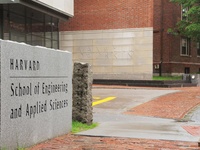Despite these uncertainties in funding, SEAS administrators say that they have planned extensively for contingencies.
“We don’t want to give the impression that we’re being complacent about this,” Fates says. “We’re aggressively optimistic.”
FINDING ROOM TO GROW
In the face of expected expansion, another potential constraint confronting SEAS is the limited amount of laboratory space—a problem Murray acknowledged at her March All-Hands Meeting, saying that space at the school was “severely constrained.”
Despite the noted space crunch, SEAS Executive Dean Fawwaz Habbal says that administrators hope to nearly double the proportion of SEAS classes that include a hands-on component—and thus require time in teaching labs.
So far, SEAS has dealt with limited lab room by reconfiguring existing space to make it more efficient and capable of hosting different experiments.
To this end, the school even brought in Director of Teaching Labs Anas Chalah in 2008 to reorganize many of the teachings labs: he installed moveable benches and multi-purpose instruments and oversaw the conversion of an outdoor lightwell in Pierce Hall into a 3-D printing facility.
But SEAS administrators say that they are aware of the continued pressure for space. Murray says that she believes the new teaching labs in Northwest and Pierce will roughly provide sufficient additional resources until the number of SEAS concentrators reaches 600. But she adds that the school could hit this benchmark in the next three years, if the number of concentrators continues to rise at its current rate.
One solution currently under discussion is the creation of an additional building between Pierce and Cruft Laboratory, a replacement for the sky bridge that currently links the buildings. The proposed building—which could have up to 12,000 square feet of floor space—could even be partially used as student social space, Habbal says.
But finding the resources to construct the building will require additional fundraising by SEAS: “We don’t have the money to build it yet,” Habbal says. “But we are planning it.”
GRADUATE GAPS
In the face of increasing financial concerns and expansion in other areas of the school, the continued support for SEAS’ graduate program may be in jeopardy.
SEAS Director of Graduate Admissions and Financial Aid Julie S. Holbrook concedes that, while not yet finalized, graduate student support is a “huge investment” for the school, and that it is “certainly something that people are talking about reducing.”
SEAS provides fellowships to its graduate students for the first year and a half, after which the students typically receive either National Institute of Health, Department of Energy, or Department of Defense grants.
These fellowships “could be” reduced in length from a year and a half to only a year, according to Murray, and such downsizing presents a more viable option than decreasing the number of graduate students.
Read more in News
New, Steady Hand at Law School













